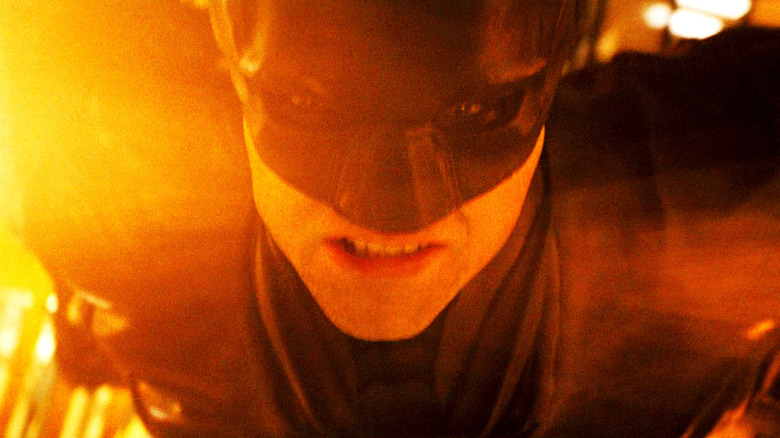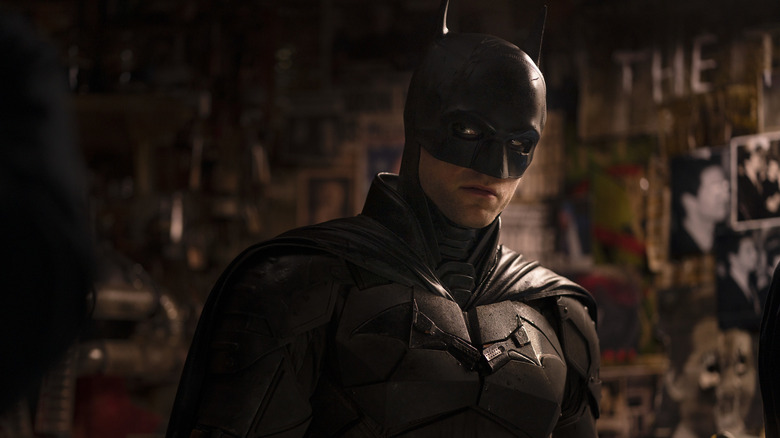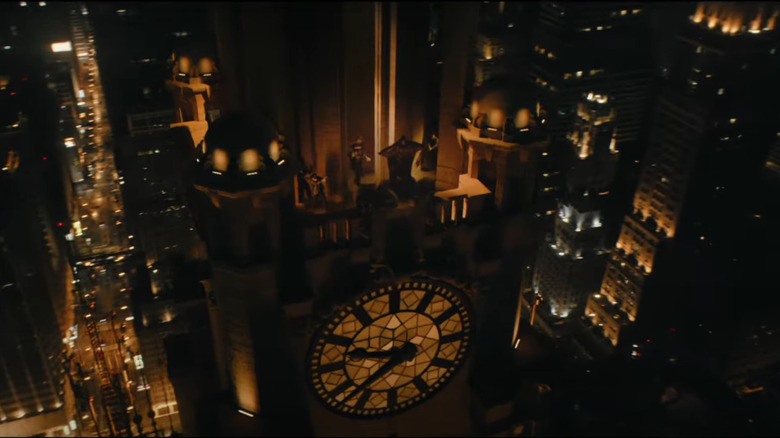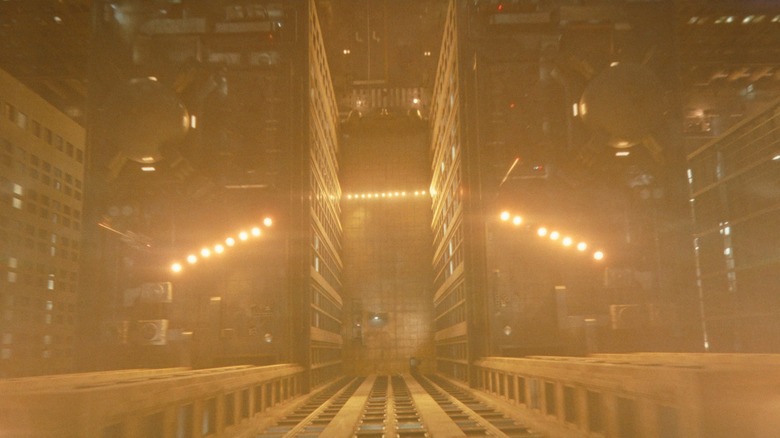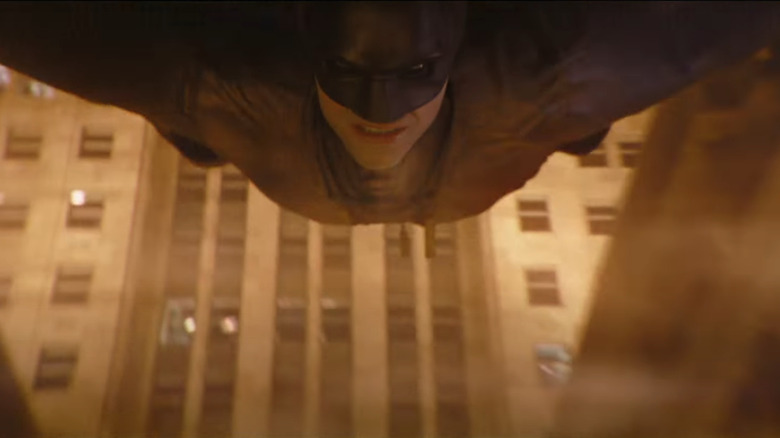How The Batman Pulled Off That Nail-Biting Wingsuit Scene
There's no way that Batman jumping off a roof doesn't look cool. Since the opening of 1989's "Batman," when Michael Keaton delivered his immortal "I'm Batman" line atop a high-rise before leaping into the smoke-filled abyss below, the Dark Knight has been using much of his time on-screen to glide around Gotham in spectacular style. "Batman Returns" was when we got the first proper "glide," wherein Keaton's hero sailed over Gotham Plaza amid a cloud of bats after being framed for the Ice Princess' murder. And impressive though that scene was for 1992, things would only get more impressive with successive Batman movies.
By the time Christopher Nolan came to oversee the franchise, Batman being able to "fly" was much more of a focus. In "Batman Begins," Christian Bale's Bruce Wayne uses a cape made of fibers that solidify once an electrical charge is passed through them. And wouldn't you believe, Chekov's (or rather, Lucius Fox's) cape comes in handy by the movie's end, when Batman uses it to quickly escape a train car, leaving Ra's al Ghul (Liam Neeson) to perish. There'd be more gliding action in the sequel, "The Dark Knight," in which Batman sails through the Hong Kong night to secure criminal accountant Lau (Chin Han). Then, it was Robert Pattinson's turn.
Filmed throughout London, Glasgow, and Liverpool, "The Batman" used the latter to great effect by having Pattinson's Batman jump from the 15-floor, 322-ft Royal Liver Building. In the movie, this scene involves the Dark Knight fleeing police headquarters, and is particularly noteworthy for managing to reinvent the gliding scene that so many Batman movies had featured before. It wasn't easy to pull off, though.
Keeping it real
Whereas the "Batman Returns" Batman ended his aerial voyage over Gotham with a sleek roll onto the city streets, Robert Pattinson's version took a real beating upon landing. But from the production team's perspective, that was an important aspect of the whole thing. "The Batman" was about a man still in the early stages of his crime-fighting crusade, driven by anger and not yet fully aware of what it means to be a hero. What's more, director Matt Reeves insisted on establishing a Gotham that felt like a real place and that reintroduced audiences to the Dark Knight's sprawling universe in a fresh way. That extended to the action itself, which at all times had to convey a visceral sense of realism so as to keep audiences immersed in the murky, urban decay that Reeves and his production designers had created.
So, when it came to the big gliding sequence, the same approach was applied. As this relatively inexperienced Dark Knight prepares to descend from the roof of the GCPD, there's no confident spread of the cape. Instead, you feel the tension and Batman's personal unease as he takes a deep breath and inflates a wingsuit unlike anything we've yet seen in a Batman movie. And it seems there was just as much unease and tension behind the scenes, where putting together the gliding sequence proved to be a lot harder than Reeves and co. were expecting.
Pandemic woes
Before the team behind "The Batman" could film anything, they needed the wingsuit itself. In a behind-the-scenes featurette, Batsuit designer Glyn Dillon explained his approach:
"In some of the previous 'Batman' comics you find Batman jumping off a building and miraculously the cape becomes like a hand glider, a huge kind of thing. You have to suspend your disbelief for a little bit for those moments [...] That presents a little bit of problem in a movie like ours where we're trying to be super realistic and super grounded so Matt [Reeves'] idea was that rather than it being like a rigid glider maybe his cape and his suit could become a wingsuit."
Dillon designed the wingsuit to form part of Batman's actual suit, which the production team had made as a real wingsuit that could be flown. As VFX Supervisor Dan Lemmon explained in the featurette, the team initially did want to shoot the whole thing for real, using a professional wingsuiter suspended from a helicopter. They even had a specialist lined up, but the pandemic put a quick stop to those plans. That must have been a blow to Matt Reeves, who went to extreme lengths to protect himself from COVID on set. Regardless, the arrival of the global pandemic meant the team had to go back to the drawing board.
'A massive headache'
Much like the badass hallway sequence in which Batman gets shot at in the pitch black, the production team still wanted the wingsuit sequence to feel as real as possible. But that proved tricky. As director of photography Greig Fraser explained, "It was quite a challenge. What seemed like a really bright idea early on turned into a massive headache about how to film it in a cinematic way."
The crew ended up using a combination of techniques to get what they needed. For the buildup to the jump, they shot in Liverpool using a stuntman in a Batsuit atop the Royal Liver building. For the jump, the team recreated the building ledge on a soundstage, and had a stuntman fall off the set while blowing what Dan Lemmon called "a ton of air" at him.
The next stage involved sending a drone down LaSalle Street in Chicago to capture footage of the area, which was then, as VFX Producer Alex Bicknell explained, "Stitched together in a 360 degree Cyclorama which we're projecting through 8mm panels." That Cyclorama was basically several screens arranged in a giant circle to create a fully immersive background, against which the team could shoot a stuntman and Robert Pattinson in the suit as they "glided" through Gotham.
The final stage was to shoot the landing, which was performed on a backlot set with a stunt performer rolling across mats. As Bicknell explained:
With a wingsuit your rate of descent is extremely fast, so in that case we can't muck around, he's gotta come down pretty quickly and it's brutal. So again, back to this grounded reality. He's not going to land there in a superhero pose, he lands there and he hurts himself."
A standout scene
In the New York Times' "Anatomy of a Scene" video for the wingsuit scene, Matt Reeves talked about wanting to shoot a classic Batman moment in a new way. He said:
"He explodes out of this moment into what would be, classically, a Batman scene where he would do something heroic and hit a button and take off. But I wanted to see how all of this was happening in this version by the seat of his pants. That Rob, as Batman, is never really in control. He's just barely making it."
The director then revealed that the shots used in the final jump are all "based on shots that [he'd] seen on YouTube of what wingsuiters actually do." The result of all this was something that feels both familiar and novel, which is a pretty good way to sum up "The Batman" as a whole.
For me, Matt Reeves' movie was a little too derivative at times, and felt like a not-as-good version of "Seven" featuring Batman. But there's no denying the "Cloverfield" filmmaker set out to try new things with "The Batman" and the wingsuit scene is one of the best examples of where he succeeded. This was a kind of subversion of the typical heroic Batman moment, and it worked. What makes it even more impressive is that the version of the sequence we see in the film was Reeves and his teams' backup plan, after having to rework everything due to the pandemic. Regardless of how you feel about the film overall, then, you've gotta be impressed by the techniques and innovation used to bring scenes such as this together. Let's hope "The Batman: Part II" pushes the originality even further.
